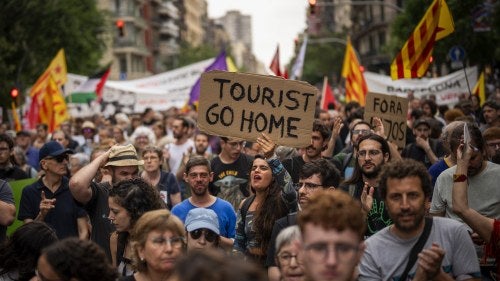As Global Cities Feel the Strain of Overtourism, What Makes Chicago Immune?

Compared to packed European cities like Barcelona and Amsterdam, Chicago faces few issues with tourists — but it agrees that short-term rentals are a threat.
The post-COVID-19 travel surge seems to have reached a boiling point in Europe this year. In Barcelona, locals shot water guns at tourists in protest of a visitor surge that has sent housing costs skyrocketing. Venice implemented a new five-euro fee for all day trippers, and in Amsterdam, lawmakers placed a ban on the building of new hotels, amid tourism growth so significant that it already spawned an ad campaign asking visitors to simply not come.
Chicago, though, hasn’t had this problem. Despite being a marquee American destination in much the same way these cities are for Europe, visitor numbers here still haven’t returned to pre-pandemic levels. And, instead of gently dissuading would-be sightseers, the city is investing heavily in trying to attract tourists, especially from abroad.
So what’s the difference?
Everything from urban planning to visitor habits plays a role. At the end of the day, though, leaders in Chicago and in Europe agree on one thing: that short-term rentals — an industry that has exploded in the past decade alongside growth in travel — must be regulated to maintain locals’ quality of life.
Where Tourists Do and Don’t Fit
Since the COVID-19 pandemic brought travel to a halt, the tourism industry across the world has been trying to get back to its pre-pandemic levels. In Europe, that milestone came in the first half of this year, when the continent saw international arrivals and overnight stays both eclipse 2019 levels by single-digit percentages. While this has economic benefits — tourists are expected to spend €800.5 billion in Europe this year — locals have not been happy with some of the complications increased tourism can bring, particularly in places with the strongest visitor growth.
Spain, for instance, had more international visitors last year than ever before — just over 85 million, compared with 83.5 million in 2019. The country has broken more records already in 2024 (the summer, for instance, saw an all-time high of 21.8 million foreign tourists), and Spaniards have accordingly been vocal about the drawbacks to what they label as “overtourism,” from infrastructure strain to short-term rental–driven housing shortages.
Chicago’s less successful post-COVID bounceback is one reason why the city has not faced similar complaints. Just 84% as many people visited Chicago in 2023 as in 2019, and, while visitor numbers are growing year over year, last year they did so only modestly.
Another key difference, though, is Chicago’s more modern and more diffuse urban plan.
“A lot of European cities have very compact city centers because they’re so old,” Michael Clancy, who researches the political economy of tourism at the University of Hartford, told ChicagoGlobal. “So the tourist centers of the city are also, in many cases, the central part of the city that make the city attractive for residents.”
This is certainly true of a Spanish city like Barcelona, where visitors and locals alike compete for space and barstools in attractive districts like Las Ramblas. But it isn’t true in a sprawling American city like Chicago. While tourist attractions like the Art Institute, the theater district, and Millennium Park may be downtown, most residents spend their time elsewhere — leaving lots of space for visitors to enjoy the city’s sights without crowding out locals.
In a statement emailed to ChicagoGlobal, the city tourism board, Choose Chicago, agreed that the city’s layout makes it easy to take in tourists.
“Chicago has a long history of playing host to the world, and we have the infrastructure necessary to accommodate 50 million-plus visitors annually,” it said. “[W]e are well positioned to continue to welcome more leisure and business travelers in the years ahead, without concerns about overtourism.”
How Habits Play a Role
Speaking technically, overtourism is defined as the issue above: too many tourists crowding into too small a space. But Clancy posits that it’s just as much a social problem.
“Overtourism occurs when a population of a given area perceives that there are too many tourists, or the wrong kind of tourists, or that the tourists are having more costs associated with their presence there than the benefits that they would provide,” he said.
In Europe, many cities have had at least as much an issue with the kind of tourists coming in as with their actual numbers. Amsterdam is perhaps the prime example of this. The city’s associations with legal marijuana use and other vices have historically drawn fairly raucous travelers who in turn engage in dangerous and illicit activities. It’s visitors like these that prompted the city last year to launch a “stay away” campaign, urging young British men in particular not to visit Amsterdam if their aim was only to party.
Some American cities face similar problems, including Las Vegas and Miami, where residents have been increasingly concerned about rowdy visitors after a record-setting year for tourism in 2023. But Chicago lacks this hard-partying reputation and the disruptive tourists that come with it.
Chicago also lacks cruise ship traffic, which Clancy describes as another problematic source of tourist inflow.
“Cruise ship tourists are notorious for not contributing very much to the economy,” he said. “They don’t eat in restaurants as much, they don’t stay overnight in hotels, because they can do all that on the ship.”
Essentially, he says, cruise passengers disembark in a city and tend to use it only for a quick walking tour and limited souvenir shopping before leaving a few hours later. That’s a hard type of visitor for cities to engage and make money from — and, in turn, it’s an area where Chicago, with its limited cruising, has a distinct advantage over European port cities like Barcelona and Venice that see millions of cruise visitors per year.
The Battle to Regulate Rentals
Despite its many differences from the tourist centers of Europe, Chicago and its leaders have done one thing that Europeans agree is key to stemming tourism’s worst effects: regulating short-term rentals.
After vacation rental companies like Airbnb surged in popularity a decade ago, the city acted in 2016 to regulate short-term rentals. The initial regulations sought to ensure that each rental is properly licensed through the city, and they attempted to prevent an oversaturation of short-term rentals by restricting how many units in a building can be used for that purpose. The city updated its regulations in 2020, including a new ban on single-night stays to try and stop visitors from hosting large parties in these rentals.
Chicago’s regulations aren’t meant to limit the flow of tourists altogether — the city has more than 7,900 Airbnb listings and, as Choose Chicago stressed, capacity is not especially strained. But by preventing buildings from being overrun by rentals and discouraging renters from throwing disruptive parties, Chicago’s regulations do seek to ensure the actions of visitors don’t reduce quality of life for locals. And that aim aligns neatly with the goals of European regulators.
In Europe, the number of short-term rental listings has exploded in the past decade, with housing costs often increasing in lockstep. Barcelona, for instance, is one-sixth the geographical size of Chicago but has a staggering 19,482 Airbnbs. This extreme abundance of vacation rentals has reduced the availability of housing for locals and, in turn, driven prices up for the housing stock that does exist: The average rent in Barcelona has increased by 68% in the past decade, compared to a 41% rise in Chicago over the same span.
European leaders, then, see short-term rentals and the vacationers that come with them as a real threat to residents — and they’re taking steps to combat the issue. Barcelona’s mayor announced this summer that short-term rentals will be banned outright starting in November 2028, bringing about 10,000 apartments back onto the rental market for residents. Lisbon, Florence, and Amsterdam have also imposed severe restrictions on short-term rentals, with some success in alleviating pressure on their housing markets.
As Choose Chicago noted, Chicago is “a community that overwhelmingly embraces tourism and understands its importance to our economy.” European cities feel these things, too. Leaders both here and abroad, though, know that manufacturing fun for visitors can’t come at the expense of having a livable city for locals.
This story first appeared in the ChicagoGlobal newsletter, a joint project of Crain's Chicago Business and the Chicago Council on Global Affairs.



